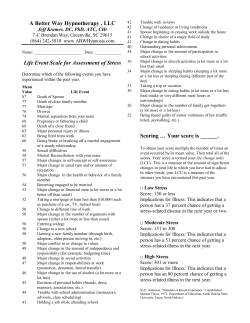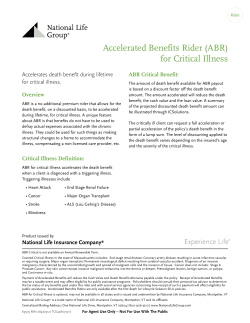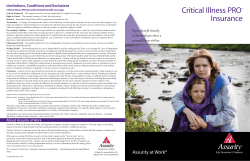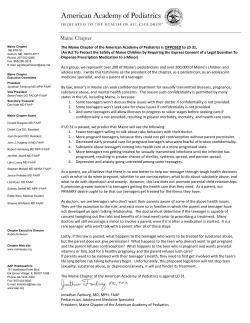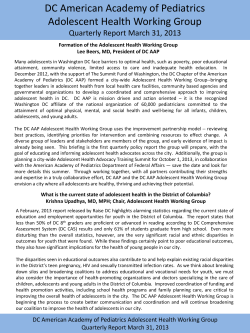
Mental Illness and Adolescent (Teenagers)
Mental Illness and Adolescent (Teenagers) With a Special Focus on Teenage Pregnancy Education and awareness has been conducted at schools and communities about the prevention of teenage pregnancies in young girls and women. Yet, alarming figures released show an increase in teenage pregnancy across the country. According to statistics: School girl’s pregnancies have doubled in the past year (2006), despite a decade of spending on sex education and AIDS awareness (SA Provincial Education Dept. Johannesburg, 6 March 2007 (IRIN). The number of pregnant schoolgirls jumped from 1,169 in 2005 to 2,336 in 2006 in Gauteng, in a country where HIV prevalence is estimated at 5.6 million people of people living with HIV and AIDS in 2009. Prevalence is 17.8 percent among those aged 15-49; the high level of teenage pregnancy has raised concerns UNAIDS (2010): “UNAIDS Report on the Global AIDS Epidemic”. 12% of teenage girls between the ages of 15- 19 years in South Africa have ever been pregnant (National Strategic Plan on HIV & Aids and STI, (2007-2011). As stated in the beginning, a lot of awareness and education around issues of teenage pregnancy has been conducted in the past and it is still continuing. The information in this document will reflect the relationship between mental illness and teenage pregnancy, focusing on the effects of teenage pregnancy on one’s mental health status. According to the Perinatal Mental Health Project: ‘Psychosocial Risk Factors’ (2009): In developed countries, 26% of teen mothers develop postnatal depression. It is speculated that the rate could be twice as high in South Africa, where 1/6 of teen pregnancies are among black African girls. Adolescence is a significant risk factor for mental illness, with mental illness being associated with high rates of maternal mortality in this age group, often due to suicide. Cognitive developmental changes and trauma are complicating factors in adolescent mental illness requiring special mental health care. The study above shows that teenagers who have children at an early age are vulnerable to the onset of mental illness. Teenagers or young women are more vulnerable to the onset of mental illness or poor mental health in the first year after having a baby if they: Have a history of mental health problems; Don’t have a supportive confiding relationship with an intimate partner; Did not plan to be pregnant or have a baby; SAFMH‐ Mental Illness & Teenagers‐ July 2011 Page 1 Have an unsettled baby, who cries for prolonged periods, wakes frequently overnight and resists soothing; Have other difficult life circumstances at the same time: academic issues or health problems; Have personal past experience of abusive relationships; Have limited practical or emotional support from family or friends; She might have conflictual relationships with her mother, family members or even her boyfriend or partner over the baby; The emotions of carrying a child whilst she is still a child herself maybe overwhelming (coping with the pregnancy itself); When the child is born, she might suffer from post- natal depression as she may not be ready to raise a child and balance her academic work; The process of child birth might be an overwhelming experience; Peer pressure might add to her stresses in that she still wants to fit in with her friends whilst some might be alienating her, or forced into going the route of abortion- having a baby much earlier than their friends who are the same age Other factors can include poor health problems such as anaemia, infections, high-risk pregnancy; a child born with medical problems could increase the risk of the onset of mental illness. YOUTH AND MENTAL ILLNESS Does this Sound Familiar? "Nobody could possibly understand how I feel." "If I start to cry, I'm sure I'll never stop." "I'm so bad that no one could ever like me." "If I don't hit something, I'm going to explode." "If people knew what I was thinking, they would say that I'm crazy." "I try as hard as I can, but I just don't understand things like I used to." "My family is driving me crazy!" "I just don't enjoy anything anymore." "I wish I could just stop feeling." Different kinds of mental illnesses are commonly seen in adolescence and have significant effects on a teenager's day to day living. Some of these include: Adolescents and depression: Many teenagers feel down and blue at times, but for some these feelings do not seem to go away but are there day and night. Life can become a chore. These teens may not realize that they are experiencing symptoms of a potentially treatable disease. Adolescents and suicide: Suicidal thinking and behaviour often go hand in hand with depression in adolescence. While some suicidal behaviour may be impulsive, all indicators of suicidal thoughts and actions should be taken seriously. Adolescents and anxiety: Many physical symptoms (such as headaches, stomach aches, or a racing heart) can be associated with anxiety in SAFMH‐ Mental Illness & Teenagers‐ July 2011 Page 2 adolescents. Feelings of fear and dread can become so intense that they can keep an adolescent from going to school, from being in a group, and from many activities that would not otherwise be a problem. Anxiety can be tied to a past trauma (for example, a car accident or incident of abuse) or an identifiable source (such as fear of snakes or heights), or present in everything one does. Adolescents and risk-taking behaviour: Many accidents can be traced to risk-taking behaviour. Risk taking is a broad category of behaviours that includes: alcohol and substance abuse, unprotected sex, thrill seeking, and delinquent behaviours. Adolescents who engage in risk-taking behaviour are likely to engage in others. Such behaviours, which can result in real tragedies, are often symptomatic of various mental illnesses. Adolescents and eating disorders: Two psychiatric eating disorders, anorexia nervosa and bulimia, are on the increase among teenage girls. They also occur in boys, but much less often. Both disorders are characterized by a preoccupation with food and a feeling of lack of control over aspects of one's life. Teenagers with anorexia nervosa are often perfectionistic but suffer from low self-esteem and an irrational belief of being overweight, regardless of how thin they become. Teenagers with bulimia binge on huge quantities of food and then purge their bodies of dreaded calories by self-induced vomiting, laxative use, and often excessive exercising. Eating disorders can be fatal. Adolescents with these disorders are typically very good at avoiding discovery. Denying the presence of their problem delays much needed help. Adolescents and conduct disorders: Conduct disorders are a complicated group of behavioural and emotional problems in adolescence. These teens have great difficulty following rules and behaving in a socially acceptable way. Their major problem is expressing anger. They are often aggressive to peers and adults, and may lie, steal, destroy property and be sexually inappropriate. Risk-taking behaviours are common in this group, including the full range of suicidal behaviours. They frequently have contributing problems including school failure and negative family and social experiences. Conduct disorders can co-occur with adolescent depression and attention deficit disorder. Mental Illness Affects Us All- It Is a Family Affair Many of the major psychiatric illnesses that are commonly seen in adults surface during adolescence. Although not directly linked, there is a strong predisposition for mental illness within families. Some families can also operate in such ways as to trigger mental illness within their members, especially their most vulnerable members. Family awareness, early identification and prevention are often the first steps to effective treatment. Relatives can play a key role in identifying and treating a teen with a mental illness, and the family members themselves often need help and support. SAFMH‐ Mental Illness & Teenagers‐ July 2011 Page 3 Don't Ignore the Signs Parents, teachers at school and friends are usually the first to recognise that an adolescent may be having significant problems with emotions or behaviour. The following signs in your teenager, student, brother, sister, classmate or friend might indicate that a psychiatric assessment will be useful. • A drop in school performance or increase in absenteeism • excessive use of alcohol and/or drugs – substances contributes to the onset of mental illness. • changes in sleeping and/or eating habits • many physical complaints (such as headaches or stomach aches) • aggressive or non-aggressive consistent violations of rights of others: defying authority, absenteeism, stealing, damaging property, etc. • withdrawal from friends, family and regular activities • depression shown by sustained, prolonged negative mood and attitude, often accompanied by poor appetite, difficulty sleeping or thoughts of death • frequent outbursts of anger and rage • low energy level, poor concentration or complaints of boredom • loss of enjoyment in what used to be favourite activities • unusual neglect of personal appearance • intense fear of becoming obese with no relationship to actual body weight • uncharacteristic delinquent, thrill seeking or promiscuous behaviour • marked personality change • comments about “feeling rotten inside”, wanting “to end things”, and “no longer being a problem for others soon” What Can Be Done to Help? The cornerstone of successful help for a mental illness is a comprehensive assessment by a child or adolescent psychiatrist, and/or other qualified professionals who coordinate information from parents, educators, and other relevant sources. Treatment can include psychotherapy (individual, family or group), skills programs (learning, social skills and behaviour) and psychiatric medication, and can be provided in a variety of inpatient, outpatient or day treatment settings, including special schools, residential placements, hospitals, private offices or community clinics. Effective treatments depend upon the strong partnership between patient, family and professionals. SAFMH‐ Mental Illness & Teenagers‐ July 2011 Page 4 Where to Go For Help Usually teenagers are most likely to tell a friend about concerns that they have regarding symptoms of a mental illness. Unfortunately, a friend might be a great listener but might not be the best person to get help. You can be a better friend by looking for signs and symptoms of mental illnesses and helping someone you know reach out to some of the following people. • Family doctor • Nearest clinic • School counsellor or teacher • Parent and other family member • Psychologist • Psychiatrist • Social worker • Help line such as the SA Depression & Anxiety Support Group: Mental Health Line- 011 262 6396 SAFMH‐ Mental Illness & Teenagers‐ July 2011 Page 5 BEING A TEENAGER TODAY! (ADDITIONAL INFORMATION) Teenage hood: a troubled period? A definite yes! Teenage hood or adolescent is between the ages of 12 and 18, a period which is marked by puberty, the body's tremendous growth surge, and by the application of formal thought which judges, criticizes, and calls the outside world into question. This is also the period of contradictions. • You need your parents, but you shut them out. • You want someone to listen to you, but refuse to confide. • You want to be free, but you still need the emotional security the family offers. • Adolescents often wear their emotions on their sleeves: they are just as quick to laugh as to cry. • This is a stage of life where imbalance, transition, experimentation, and challenging keep company with selfassertiveness, contrariness, and sometimes even marginalization. Our constantly changing world is not always a help. Yesterday’s guideposts have disappeared without necessarily having been replaced. Choices and possibilities have multiplied. Youth evolve in a playing field, which often overwhelms them. There is the matter of sexuality. Nothing much is any longer taboo in our days. Everything is expressed, reported, shown and explained. Youth know more than ever about sexuality. The "free and open "society in which they now live in persuades them that if they put off having sex, they will be considered weird. Result: they are more than ever, slyly being made prisoners of their fears and anxieties. Given healthy guidelines during this necessary period of experimentation, adolescence can still be an exciting and formative stage in life. In their search for identity, youth can be brought to relate to themselves as a coherent whole maintaining harmonious relations with the environment. However, if left alone with the illusion that they have total control over everything that happens to them or else repressed in their need for self-assertion and autonomy, youth risk experiencing adolescence as a trip through the desert. There is even the risk of their getting lost in that desert. Psychological distress, a traumatic event or even some of modern life's curve balls (for example, heartbreak, the divorce of one’s parents): all these may disturb a young person's mental health without giving any grounds to speak of a mental illness with psychiatric diagnosis. Hence, it is important to recognize the subtle signs of distress, so as to respond proactively and refer the troubled youth to a competent professional. When should we sound the alarm? Most youth get through adolescence without too much damage and manage to build an adult life in keeping with their aspirations. However, for a thousand and one reasons, a number of young people have a much harder time living out SAFMH‐ Mental Illness & Teenagers‐ July 2011 Page 6 their adolescence. Some even feel quite literally sucked down. These young people take many paths on their way down: school drop-out, drugs, depression, eating disorders, suicide. Youth finally have many ways of letting us know things are not going well. But they must first be heard. Certain signals can be a tip-off allowing adults to detect their teenager’s SOS and take appropriate action: • When an adolescent no longer wants to see his friends (the same ones he once couldn't breathe without), • When he loses interest in things that were once a passion and finds everybody "stupid "starting with him, it’s safe to say that this adolescent deserves our concern. • Physical health can also be an important indicator. • Too much or not enough sleep, constant fatigue or an eating disorder is telling signs of distress. • Sudden hyperactivity, exaggerated or forced euphoria can also camouflage an under- lying state of anxiety. Such symptoms should not necessarily be diagnosed as a mental illness, but rather seen as concrete indications of distress. However, if any of these symptoms should change the adolescent’s behaviour, mood, emotions, thought patterns and perception to the point where he has trouble with day-to-day activities, it may be justified to think of them as early signs of a mental illness. The concerned adult should watch for the intensity, accumulation and duration of the distress signals. We should keep in mind that adolescence anxiety is a broad category but can’t explain everything. Real and serious symptoms of mental illness are too often and too easily tossed into this category. Knowing how to recognize such symptoms and consult professionals who can diagnose and treat them competently is sometimes the best route to follow. Remember: Listed below are the traumas that can affect the normal development of youth and disturb their mental health. • Absence of intergenerational communication. • Absence of significant others. • Frequent moves- i.e. moving of houses. • Experience of abuse or violence. • Experience of prolonged separations (death, divorce, etc.). • Many foster or institutional placements. • Family problems. • Mental health problems in a parent or a member of the immediate family. SAFMH‐ Mental Illness & Teenagers‐ July 2011 Page 7 GENERAL SYMPTOMS OF MENTAL ILLNESS Categories of symptoms Examples. A social behaviour Apathy, withdrawal, drop out from cultural and leisure activities. Change in behaviour Hyperactivity or inactivity, substance abuse, unusual touchiness, recklessness, abnormal posture, drop in personal hygiene and attention to appearance, change in sleeping and eating habits, inability to wash and feed oneself. Depression Serious change in appetite or weight, pessimism, suicidal words or thoughts, lack of interest in activities, extreme fatigue. Emotional disorders Indifference, inappropriate laughter, continuous crying or inability to cry, unusual hostility, inability to express joy, exaggerated fear and distrust. Thought disorders Trouble with concentration and memory, confused thinking, confused speech patterns, absurd remarks, trouble dealing with minor problems, impaired reasoning. Cognitive and perceptual problems Short-term memory problems, inability to wash and feed oneself, inability to resolve everyday problems. SAFMH‐ Mental Illness & Teenagers‐ July 2011 Page 8 ACTIVITIES FOR YOUTH THAT CAN BE USED TO HELP We need to encourage an environment where: IT 'S COOL TO TALK ABOUT IT! (Talking about mental illness in youth) Activity Objectives: For Young People to• • Become aware of their strengths which contribute to their stability Understand that speech is the most powerful tool to end isolation. Should you observe that some learners show signs of serious problems after participating in these exercises, please refer them to the school’s social worker, psychologist or any mental health service providers and advice of these services. Ask the learners the following questions: • Is it possible to imagine that a teenager may be stressed? (like an adult) • Where does excess stress lead to? (Pursue the idea of personal imbalance, drug use, suicide, violence, etc.). 1. Question/Problem Ask the learners to define mental health. Ask the learners to define mental illness. Ask the learners to explain the link between mental illness and the theme (IT 'S COOL TO TALK ABOUT IT!) Try to bring out the following ideas: • Mental health is a matter of balancing all aspects of our lives: physical, mental, emotional, social, family and school. • Mental illness is very common. It is a term that refers to all the different types of mental disorders, including disorders of thought, mood or behavior. • The theme suggests that, if confronted with personal problems, we must be open about them and discuss them, even consult. • Remind learners that the expression "he's crazy" is derogatory and can reinforce existing prejudices concerning mental illnesses. It can even result in some individuals not seeking needed help. Seeking help is important not only when we are not feeling well but also at moments when we wish to see things more clearly, to understand what’s happening to us. Underline that the important question these activities will attempt to answer is the following: How is it possible to maintain one’s personal balance or mental health? 2. Exploration/Discovery Stage 1 "Talking about what promotes my stability/ balance and what hinders it, is cool." SAFMH‐ Mental Illness & Teenagers‐ July 2011 Page 9 Ask the learners to bring various magazines in which they can cut out. Provide large pieces of cardboard and the material needed for a collage. Explain to them that they are window- dressers and that they must design two window displays aimed at adolescents. One window must illustrate what can contribute to an adolescent’s personal stability. It may feature a product (ball for sports, movie advertising for leisure) or a symbol (heart for love, handshake for friendship). The second window must show various factors that contribute to stress and threaten a teen’s personal stability. It may feature a product (Nintendo, alcohol, money) or a symbol (scenes of violence, pregnancy, divorce of parents). The collages prepared by the students are hung on the walls of the classroom. Each team explains its project to the group. Stage 2 "Talking about my emotions is cool." Remind learners that there are no positive or negative emotions; there are only pleasant and unpleasant emotions. It is the actions associated with these emotions that are positive or negative. Distribute the following chart and ask learners to put an X in the columns representing what they feel personally. There may be more than one X per emotion. Emotions Emotion I often feel and makes me feel good Emotion I often feel and makes me feel bad Emotion I can easily detect in other people Emotion I cannot easily detect in other people Anger Aggressiveness Excitation Fear Grief Guilt Joy Love Peace Pity Pleasure Rejection SAFMH‐ Mental Illness & Teenagers‐ July 2011 Page 10 Once this exercise is completed, ask them to answer the following questions, which are on the same sheet: • What are the positive aspects in this portrait · of your emotions? • What are the negative aspects in this portrait of · your emotions? • What would you like to improve? • How will you go about it? • You may ask the learners to exchange papers and discuss the results. Stage 3 "Talking to my inner voice is cool." Remind learners of the existence of a little inner voice. At times we have great difficulty silencing this voice and it can be both a friend and a fearsome enemy. It has a direct effect on our self-esteem as well as on our emotions and our level of stress. To better understand this; let us think about the following inner statements: • "I am worthless "; • "Nobody loves me "; • "Everybody hates me "; • "I'll never amount to anything ". Imagine the impact of this voice if these statements have been repeated for 10 years. Yet, the little voice could also be saying: • "You are nice ", • "You are good ", • "You can do it". Impossible to hide from it, this voice follows us everywhere...We might as well attempt to tame it, take control of our little inner voice, rather than allow it to cripple us with unkind words. Ask learners to change the inner dialogue for each of the following situations: 1. A girl asks a boy to dance. He thinks to himself: She only wants to make fun of me and make me look stupid. 2. A girl shows her father a report card that is not very good. She thinks to herself: If I start by telling him off, maybe he'll leave me alone. 3. John must begin a complicated maths homework assignment. He thinks to himself: I might as well not do it, I won't understand anything anyway. 4. Julie receives praise from her teacher for raising her average from 50% to 60%. She thinks to herself: What a hypocrite, she knows that I am not good. She only congratulated me so I will keep quiet in class. 5. Jennifer teases Robert because of his acne. He thinks to himself: I know that I 'm ugly! All the girls feel the same about me. SAFMH‐ Mental Illness & Teenagers‐ July 2011 Page 11 Complete this exercise by asking the learners to share some of the positive inner thoughts they found for each situation. Encourage them to become aware of their inner dialogue and avoid: • expressions that generalise (always, never, everyone, nobody); • negative expressions (not good, not able, not attractive, not nice). Encourage them to use kinder words (I am nice, I am intelligent, I am attractive and capable). Stage 4 Summarise and provide an organised answer to the main question. One of the key elements in maintaining mental stability is, without doubt, a healthy lifestyle. Needless-to-say that mental health is nourished by physical activity, sound eating habits, restful sleep, social activities and interesting hobbies. Nevertheless, everyday events, life's trials and tribulations, and unfortunate incidents continue to threaten us. Although we may have a healthy lifestyle, we may not necessarily possess all of the skills needed to deal with these situations. It is therefore useful to develop and to cultivate these skills, for example: the ability to manage stress and emotions, to solve problems, to develop self-esteem, self-confidence and self-affirmation, to communicate with others, and to seek social support. Despite all of these protective factors, coping with a difficult situation such as a death or dealing with abuse may prove impossible. It is important to remind youth that they can always find a trustworthy person to listen to them and appropriate professional help to guide them towards a solution. The important thing is to rediscover happiness. Unhappiness can kill bit by bit or in a flash, without discrimination. Activity 2 The activity helps young people to have the ability to talk about oneself. • If there is no one in the class that you can trust, is there anyone outside the classroom? Can you name these people? • Which aspect of yourself do you most enjoy talking about? • What aspects of your life do you not like discussing? • Why is it important to have someone to confide in? • Are you a person one can confide in? Explain. • Have you ever had a particularly interesting experience where someone confided in you? What was it about? How did you feel? • Have you ever had a disappointing experience where someone betrayed your trust? What was it about? How did you feel? • If you had a serious personal problem, would you consult a health professional? Explain your answer. • What do you think can happen to a person who goes through life always isolated from others? SAFMH‐ Mental Illness & Teenagers‐ July 2011 Page 12 • • Do you believe in friendship? How do you perceive it? Do you believe in living as a couple? How do you perceive this? SAFMH‐ Mental Illness & Teenagers‐ July 2011 Page 13
© Copyright 2025

